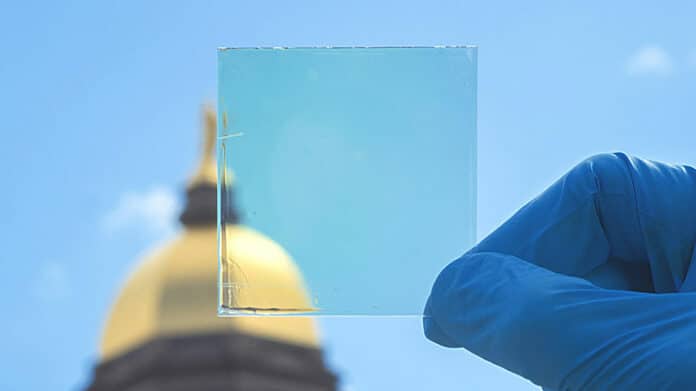Windows are an essential feature of any building, as they allow natural light to brighten up the interior spaces. However, they can also bring in unwanted heat, which can cause discomfort and increase energy usage.
The angle between the sun’s rays and the normal vector of the windows changes throughout the day, and when the sun is directly overhead, the solar incident angle is high, resulting in a significant amount of heat entering the space. While spectral filters have been developed for thermal management, many of them are not effective at high incident angles, reducing visibility and making them less practical.
Now, researchers at the University of Notre Dame have developed a new window coating that blocks heat-generating ultraviolet and infrared light and allows for visible light, regardless of the sun’s angle. This technology can be applied to existing windows or automobiles and can potentially reduce air-conditioning cooling costs by more than one-third in hot climates.
“The angle between the sunshine and your window is always changing,” said Tengfei Luo, the Dorini Family Professor for Energy Studies at the University of Notre Dame and the lead of the study. “Our coating maintains functionality and efficiency whatever the sun’s position in the sky.”
Researchers fabricated a transparent window coating by stacking ultra-thin layers of silica, alumina, and titanium oxide on a glass base and adding a micrometer-thick silicon polymer to enhance the structure’s cooling power. The silicon polymer reflects thermal radiation through the atmospheric window and into outer space.
The order of the layers had to be optimized to ensure the coating could handle multiple angles of solar light, but due to the immense number of possible combinations, a trial-and-error approach wasn’t practical.
The team optimized the configuration of layers to maximize visible light transmission while minimizing the passage of heat-producing wavelengths. They used quantum computing, specifically quantum annealing, and experimentally validated their results.
The coating they produced maintained transparency and reduced temperature by 5.4 to 7.2 degrees Celsius in a model room, even when light was transmitted in a broad range of angles.
“Like polarized sunglasses, our coating lessens the intensity of incoming light, but, unlike sunglasses, our coating remains clear and effective even when you tilt it at different angles,” Luo said.
This coating is a great example of how active learning and quantum computing can be used to design a variety of materials with complex properties. The scheme used in this project can potentially be applied to the creation of other innovative materials in the future.
Journal reference:
- Seongmin Kim, Serang Jung, Alexandria Bobbitt, Eungkyu Lee, Tengfei Luo. Wide-angle spectral filter for energy-saving windows designed by quantum annealing-enhanced active learning. Cell Reports Physical Science, 2024; DOI: 10.1016/j.xcrp.2024.101847
